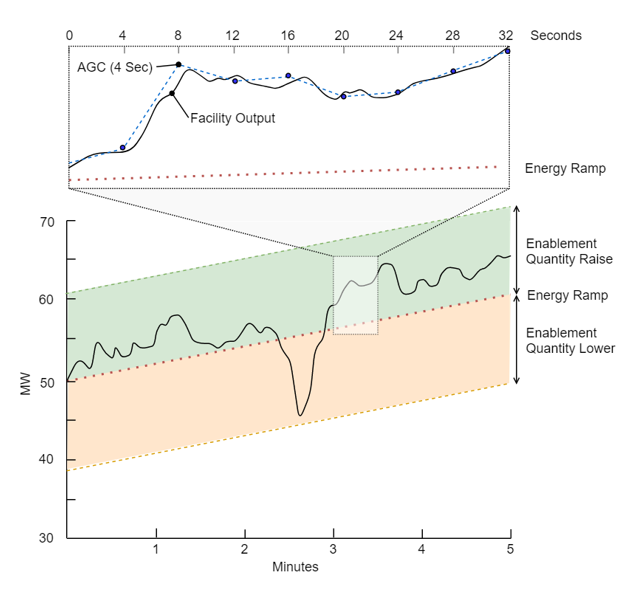Summary of Frequency Co-optimised Essential System Services
Summaries of the various Frequency Co-optimised Essential System Services (FCESS) can be found below.
Regulation
Regulation is the service, measured in MW, of frequently adjusting the Injection or Withdrawal of a Facility in accordance with an AEMO centralised control scheme in order to assist in maintaining the SWIS Frequency according to the Frequency Operating Standards. The Regulation service has both a raise and lower component.
Regulation Raise
Regulation Raise is a Regulation service, measured in MW of response capability, that operates to raise the SWIS Frequency.
Regulation Lower
Regulation Lower is a Regulation service, measured in MW of response capability, that operates to lower the SWIS Frequency.
Regulation Service providers must be able to operate under AGC and meet the Performance Requirements specified in the FCESS Accreditation WEM Procedure, along with the SCADA and communication requirements in the Communications and Control Systems WEM Procedure.
In accordance with paragraph 2.4.3 of the Communications and Control Systems WEM Procedure, the maximum communications lag time for Regulation Service providers is 5 seconds. This represents the time lag between the Facility PPC receiving the desired MW signal from AEMO and responding – i.e. t2 – t1 in the figure below:
Regulation Service providers must also have the SCADA points listed in the Operational Data Points Technical Specification, which may be varied by AEMO for specific Facility configurations. Additional information on the AGC logic and hand-shaking for Regulation Service providers can be found in the Technical Specification: Automatic Generation Control, SCADA Dispatch Instructions, and Fast Start Facility Operational Behaviour.
Contingency Reserve
Contingency Reserve is the service, measured in MW, of holding response capability associated with a Facility in reserve so that the relevant Facility can rapidly adjust Injection or Withdrawal in order to assist in maintaining the SWIS Frequency according to the Frequency Operating Standards after a Contingency Event – for example, avoiding UFLS for a single Credible Contingency Event.
Contingency Reserve Raise
Contingency Reserve Raise is a Contingency Reserve service, measured in MW of response capability, that enables a Facility to adjust Injection or Withdrawal to arrest the decline of SWIS Frequency so that it can be raised back to the normal operating range.
Contingency Reserve Lower
Contingency Reserve Lower is a Contingency Reserve service, measured in MW of response capability, that enables a Facility to adjust Injection or Withdrawal to arrest the increase of SWIS Frequency so that it can be lowered back to the normal operating range.
Contingency Service providers must meet the requirements specified in the FCESS Accreditation WEM Procedure and may be required to operate under AGC in order to support Frequency recovery following a Contingency Event (see the Technical Specification - AGC, SCADA Dispatch Instructions, and Fast Start Facility Operational Behaviour for more details on ‘Assist’ mode operation). In addition, Contingency Service providers must have high resolution time-synchronised data measurements available to monitor the service as per the requirements in the Communications and Control Systems WEM Procedure.
In accordance with paragraph 4.1.1 of the Frequency Co-optimised Essential System Services Accreditation WEM Procedure, AEMO has determined the Maximum Contingency Reserve Block Size:
| Maximum Contingency Reserve Block Size |
|---|
|
65MW |
Rate of Change of Frequency (RoCoF) Control Service
Rate of Change of Frequency Control Service (“RoCoF Control Service”) is the service, measured in MWs, of providing Inertia which provides an instantaneous response to slow down the rate of change of the SWIS Frequency.
The RoCoF Control Service has two functions:
- To ensure that the Rate of Change of Frequency is restricted to below a certain maximum level; and
- To ensure that minimum Frequency requirements are maintained by potentially allowing a trade-off between the amount of reserve required and the amount of Inertia on the power system.
RoCoF Control Service recognises the interplay between the size of a contingency, the level of system Inertia and Contingency Reserve Raise Service.
RoCoF Control Service providers must meet the requirements specified in the FCESS Accreditation WEM Procedure and must have high resolution time-synchronised data measurements available to monitor the service as per the requirements in the Communications and Control Services WEM Procedure.
Procuring FCESS
In the Security-Constrained Economic Dispatch (SCED) Market, FCESS is procured via a market mechanism, with accredited Facilities having the opportunity to offer prices for the relevant services to be potentially cleared in dispatch.
Accredited Facilities are able to submit offers into the Real-Time ESS Markets based on their accredited parameters which are part of their Standing Data.








